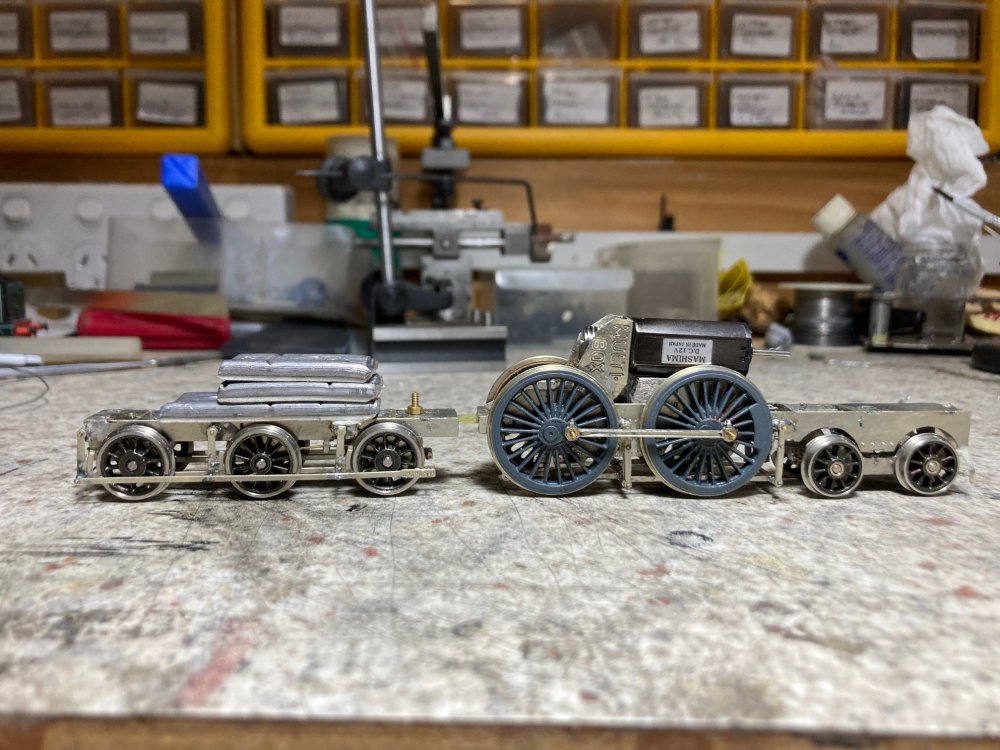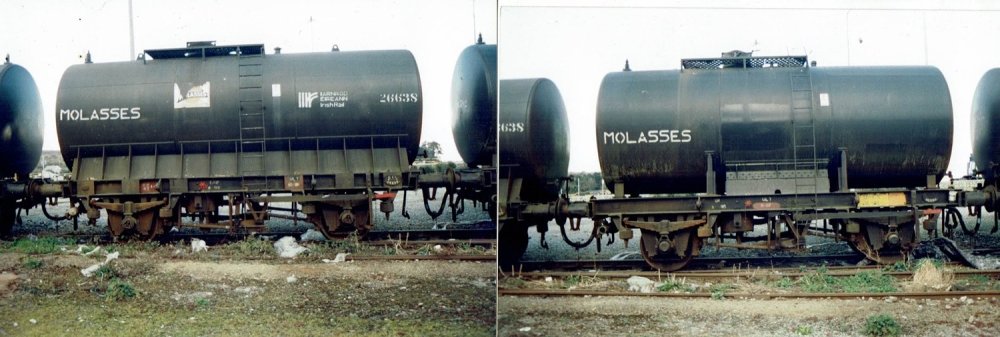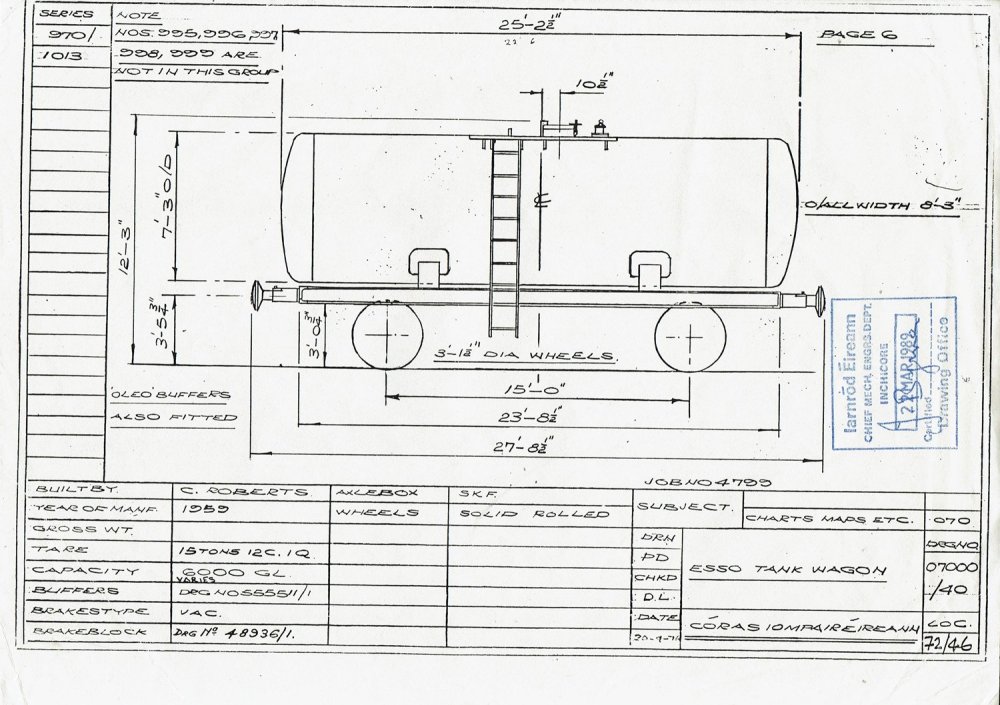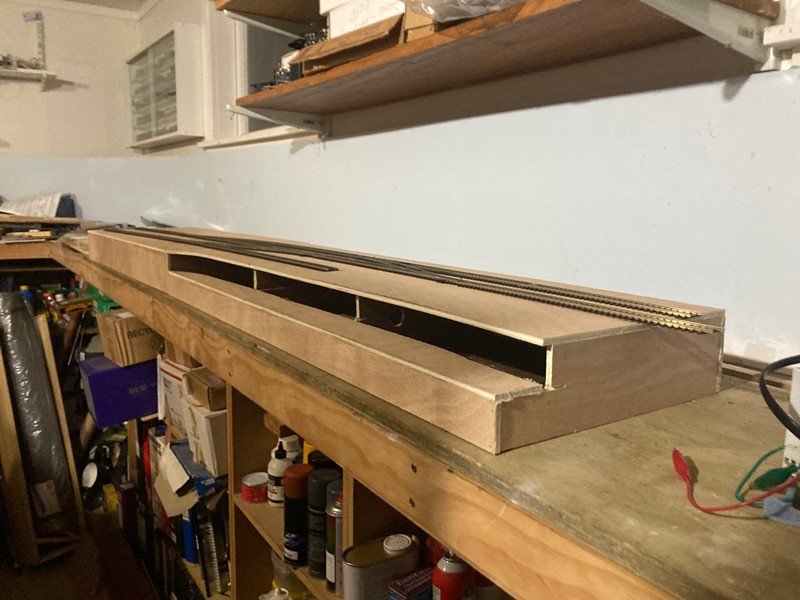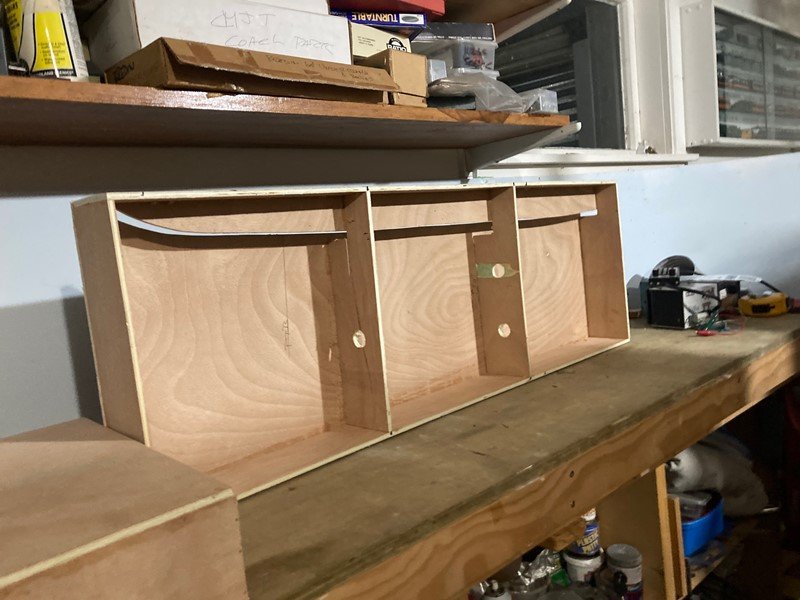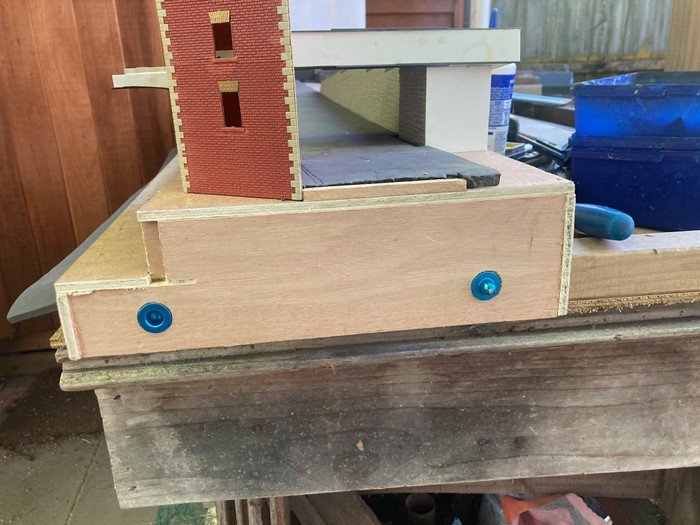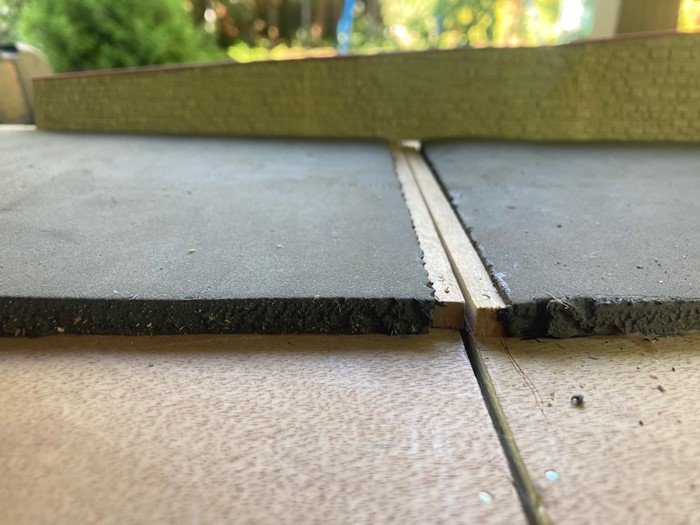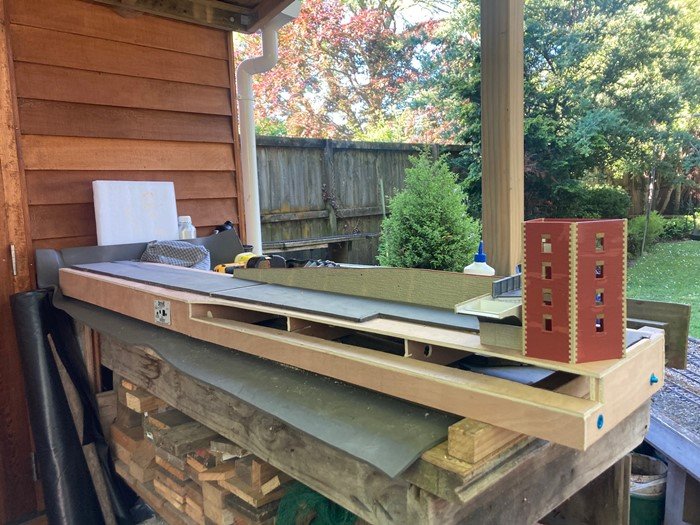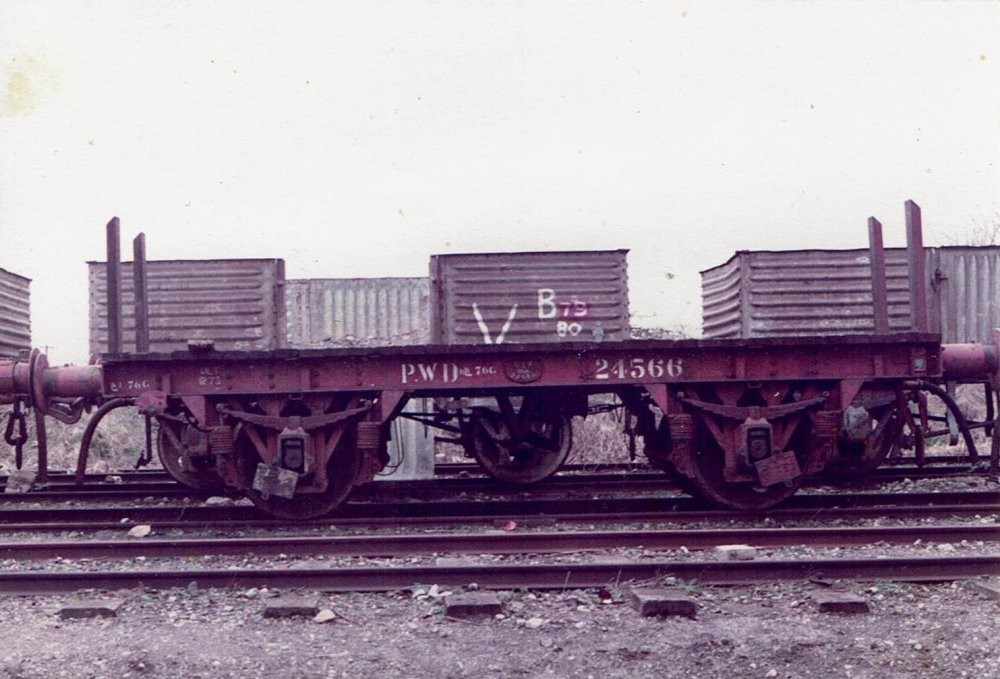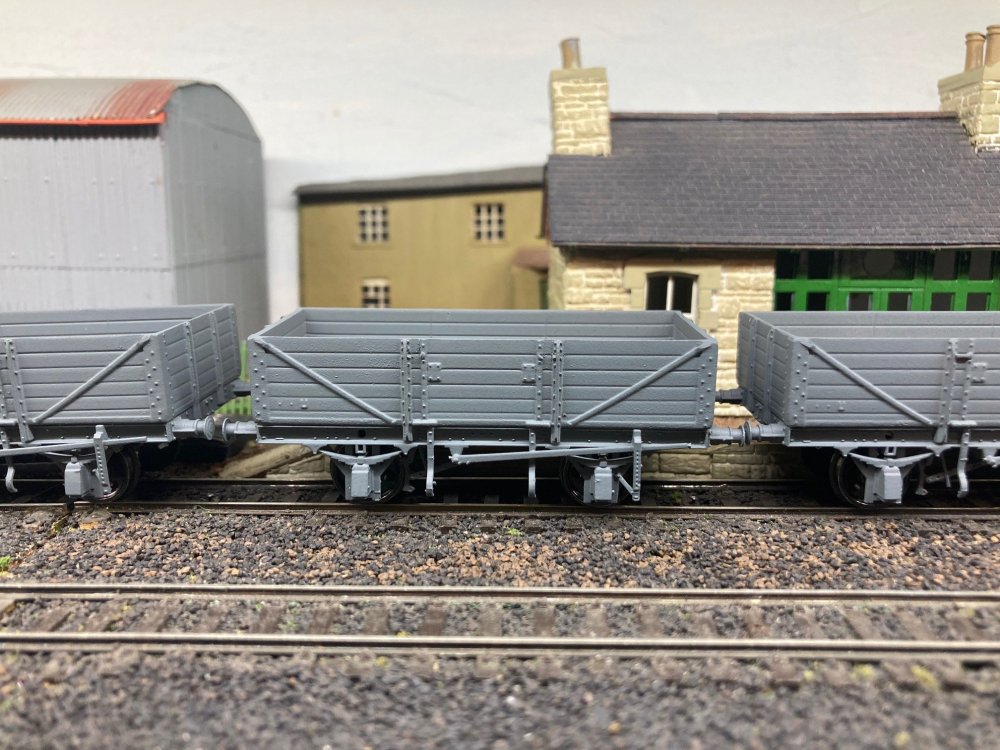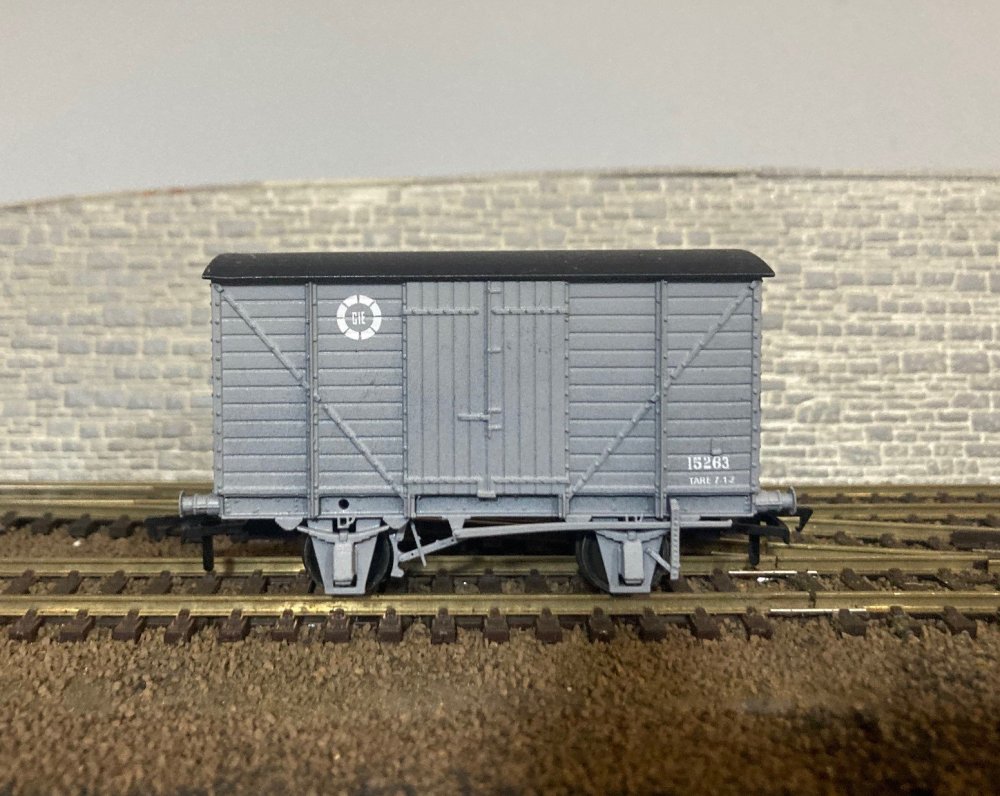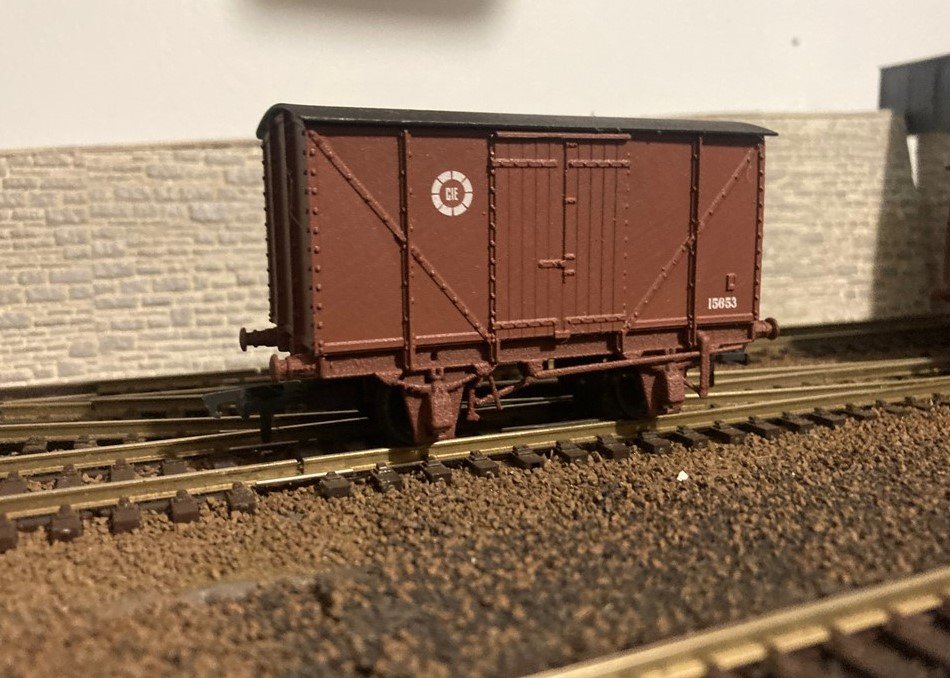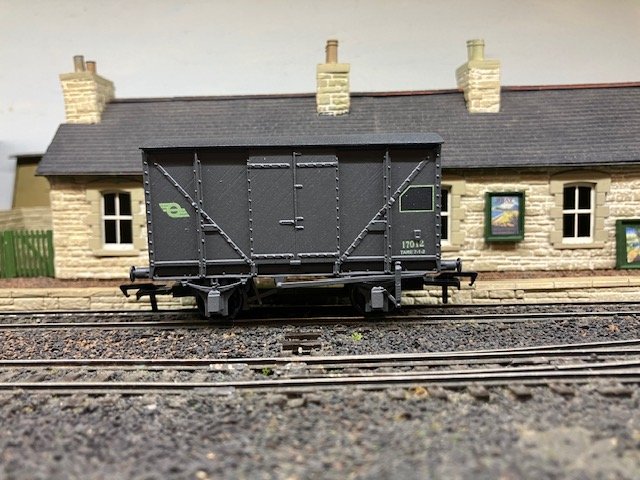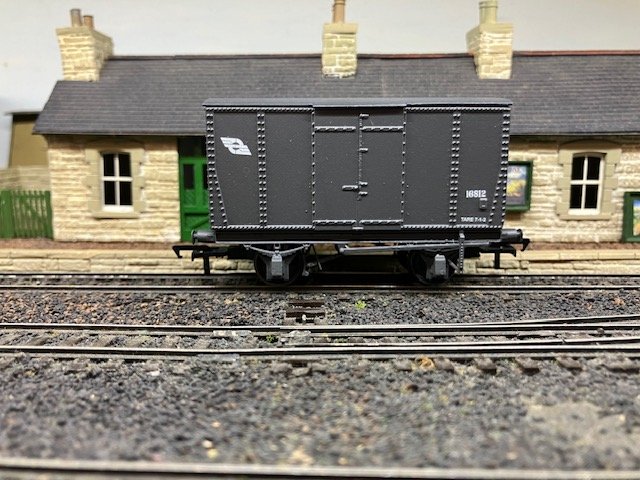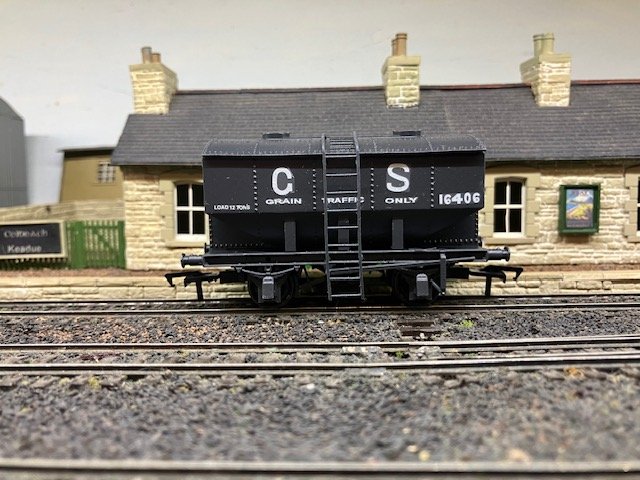-
Posts
4,858 -
Joined
-
Last visited
-
Days Won
119
Content Type
Profiles
Forums
Events
Gallery
Blogs
Store
Community Map
Everything posted by Mayner
-

Ernies Massive Irish 1930's to 2005 Photo Archive
Mayner replied to Glenderg's topic in Photos & Videos of the Prototype
There is a story of Bulleid explaining his concept of a fireless main-line loco to a group of workers during an after dinner strole around the Tender Shop during his early days at Inchacore. It appear the guys asked Bullied about his plans for a new loco and he drew up a sketch (concept drawing) of a fireless loco that would be 'topped up' at a series of charging stations around the network. I guess we will never know whether there is some truth to the story. The ESB substantially increased it power generation capacity from Hydro and Peat from the late 40s onwards against a background of economic stagnation and a falling population. The railways may have been seen as a means of absorbing some of the additional capacity in the same way as the GSR was enticed (manipulated) into building the Drumm Battery trains by the offer of 'cheap electricity' from the Shannon Scheme. Whatever about fireless locos topped up by lineside generating plants, development of the Drumm principal with partial electrification would have been feasible and fitted in with the social and economic aspirations of the 1st 'Inter-party' Government elected in 1948 (Declare a Republic, attempt to set up a 'Welfare State" (Mother and Child scheme) based on the UK model, and lay groundwork for the Republics economic transformation from the 60s onwards. A change from a railway a railway that mainly exported cattle and people, to one that carried mineral and manufacturing outputs to the ports from the 60s to the 90s to the contemporary railway that mainly transports commuters to their offices in the cities. Faced with the reality of a stagnant economy, the railway worsening financial position, CIE had to modernise 'on the cheap" with diesel traction and cheaply built stock good for 20 or so years. Still at the end of the day a modern variant of Drumm's Battery trains are likely to resume operation in Ireland over 90 years after the initial trials on the GSR. -
Its difficult to envisage countries with a much lower population density than countries such as France, Germany or the Benelux Countries replacing air and long car journeys with European-style passenger rail services. Ireland has a low population density at 76 people per Sq/Km compared with France 120Sq/Km, Germany 243, England 297 and less urbanised at 60% compared with Western European countries at over 80%. More likely a citizens revolt over having to pay high taxes and rates to subsidies public transport, rather than conspiracy theories about Socialist Governments forcing us to use rail or motor industry Hit-men. I very much doubt that the Irish public would be prepared to pay the high level of fares or taxes required to support a high speed/high frequency European passenger rail service. The New Zealand Transport Minister recently advised Wellington and Auckland cities that they will have to substantially increase train and bus fares as farebox revenue in both cities in now below 25% of operating costs. Farebox revenue in cities such as Vienna and Oslo contributed 50% revenue pre-Covid and in many countries commuter rail passenger numbers have not returned to pre-Covid levels as working patterns have changed considerably since the 1980s. Strangely much of the current push for people to resume commuting and return to their office is driven by Financial Institutions with a major risk of ending up with 'stranded assets' as city center office blocks, business districts and transport assets become redundant if people no longer need to commute to the city to work. Although there has been a lot of talk about 'remote work' and people working from home being a post Covid thing, I worked largely remotely for an Irish Government agency for two years before leaving for New Zealand in 2004. These days I pay almost twice as much in rates on our house as in income tax. A high proportion of our rates goes towards maintaining the local roads and subsidising local public transport services (which I don't use)
-

Ernies Massive Irish 1930's to 2005 Photo Archive
Mayner replied to Glenderg's topic in Photos & Videos of the Prototype
Interestingly some of the large Coey era GSWR 4-4-0s retained tapered boilers until rebuilt by the GSR with superheated boilers during the 1930s. Apparently tapered boilers were introduced during the 1900s to keep the axleloading of the 321 and 333 Class 4-4-0s within the Civil Engineers limits. Some of the 4-4-0s were rebuilt before the (1925) Amalgamation with new heavier frames, but retaining the original tapered boilers after axle loading was increased following the re-laying of the Main Line. The 800 Class & Drumm Battery trains. There was certainly an element of national pride in the 800 Class and Drumm Trains C&D also introduced 1939. C&D had a modern contemporary appearance not unlike the LMS Leyland articulated railcar set trialed on the Oxford-Cambridge line around the same time. C&D were let down by using refurbished batteries from the original Drumm trains A&B, the refurbished batteries becoming life expired after approx 5 years. -

Ernies Massive Irish 1930's to 2005 Photo Archive
Mayner replied to Glenderg's topic in Photos & Videos of the Prototype
According to A Decade of Steam RPSI 1972 and Locomotives of the GSR 401 reverted to Walscherts valve gear in 1949 possibly to provide parts to keep 406 running, but I haven't seen photos of 401 in2 clinder form with Walscherts gear. W McDonnell Running Foreman Cork wrote the section of the 4-6-0 in a Decade of Steam from an enginemans perspective and considered 402 the "best of the class" as the most powerful and reliable. In practical terms 402 and the two Caprotti valve gear engines 401 and 406 were practically new locomotives when rebuilt with new frames, cylinders, wheel centres and motion. 402 was basically an express passenger version of the 500 Class originally introduced as a mixed traffic loco. The 800 Class may have been as much a prestigious project to demonstrate the Free States technical and engineering ability as well a its traffic needs in a similar manner to the Drumm Battery Trains. Apparrently the 800 Class were fitted with parrallel boilers with tapered cladding which would have contributed to the similarity in general appearance between the Rebuilt-Royal Scots LMS and GSR 800 Class -
A Jan 2024 Irish Times article paints quite a different picture with the Dublin Port Company downplaying increased rail usage in its expansion plans and the Transport Minister Michael Martin 'encouraging' the Port Company to make increased use of rail, including a instruction to model (carry out a feasibility study) of railing container traffic between the IE North Wall Depot to an 'alternative site" (Inland Port) outside of the Port. https://www.irishtimes.com/ireland/dublin/2024/01/17/dublin-port-downplays-increased-role-for-rail-freight-in-expansion-plans-despite-ryans-concerns/ The Port's argument appears to be that rail traffic through the Port has been falling and that "de-carbonisation" may be achieved more quickly and effectively with 'low-emission" trucks through the Port Tunnel & Motorway network. As far as I recall there was talk of Dublin Port closing rail access to the Alexandra Road Terminal at some stage this year in order to improve road access to the terminal through a flyover (for trucks) over Alexandra Road.
-
I locate the two front axles in slots in all my 2-4-0s and 4-4-0s, added weight at the front of the tender and found that it works fine. I copied the idea of using slots from the TMD/SSM GNR S Class tender as a practical way of assembling/building a "Sharman Free Tender" and it seems to work quite well. 2-4-0s and 4-4-0s I have built successfully hauled 15 IRM Ballast wagons of 10 of my heavier less free-running 3D printed wagons
-
Two wagons were introduced in red & white for petrol and four in blue for fuel oil traffic between the Burmah Tivoli and Limerick terminals. The red and white Burmah scheme appears to have been a variation of the red stripe on a silver or light grey tank tank barrel for hazard Class A (highly flammable liquids) tank wagons. Nice to see a page from the CIE Railfreight diagram book, I got to have a look at it a couple of times in the 70s. It would be great if the Diagram Book was made available throught the IRRS or published as it included both diagrams and photos of wagons, containers and swapbodies in service at the time. The Burmah tank wagons were used for Mollasses traffic in the 1990s along with tank wagons originally introduced for Oil from Foynes to the Limerick and Drogheda cement factories during the 60s. Although on a similar 20T vac braked chassis the "Irish Cement" tank wagons appeared more conventional in design on a purpose built chassis the tanks having conventional anchor mountings. Mollasses Tank wagons stored Foynes c:2000. 26638 possibly built for Cork-Ballinacourty oil traffic similar design to Burmah Class B tanks. 26570-26589 series tank car introduced for Oil traffic to Cement Factories 1966. CIE Diagram Charles Roberts 1959 built ESSO Tank Wagon 970-1013. Interestingly diagram notes that 995-999 are not in this group.998 appears to have been a "Jumbo: Bitumen wagon, While the majority of ESSO tank wagons had the long barrel that extends over both ends of the underframe (headstock) I saw at least 1 wagon with the shorter tank barrel modelled in the Airfix and Dapol kits during a visit to East Wall yard but was more interested in the older tank wagons stored/dumped in the yard at the time and did not take photos or numbers!
-
I successfully used all ply (6mm) construction on my East Dock/ North Wharf shunting layout in 2021, all joints were glued with PVA and pinned with 20mm panel pins. Diagonal bracing or trinagulated framing is un-necessary with a largely solid baseboard baseboard top, but short sections of stripwood 35X35 (White deal PAO (Planed all round) available from Chadwicks or other merchants can be used to reinforce the joints between the vertical framing members if you prefer a screw fixing. https://irishrailwaymodeller.com/topic/10731-east-dock-an-irish-timesave-ish/ I would normally use thicker ply but had some nice 6mm ply over from a wall lining job, 9mm should be more than adequate for your baseboards. One of the baseboards is recessed for a Quay/Dockside The holes in the framing are for the wiring The plybaseboards are sitting on baseboard framing set up for a 'permanent" layout about 10 years ago now mainly used as a workbench and for storage, as you grow older you find out that things seldom work out as planned. Baseboard alignment dowels are from DCC concepts https://www.dccconcepts.com/product-category/track-and-track-making-parts/baseboard-alignment-dowels/ Track underlay is grey foam camping mat with strip of hardwood of the same thickness as a support where the track/rails cross baseboard joints.
-
Oil and Bitumen tanks appear to share the same chassis. I suppose the question is whether its worth while replacing/increasing the diameter of the existing tank, or there is enough potential demand for a manufacturer/retailer to commission a RTR version of an ESSO Bitumen Tank wagon. Visually there is not a lot of difference between the two types. Grungy coat of black to may be the simplest Bitumen tank conversion option. 998 is the no of the one in the IRRS Cahir Abbey photo same tank mount original tank mounts as the Paul Bartell photo https://paulbartlett.zenfolio.com/essobitumenrebuilt https://paulbartlett.zenfolio.com/essoatankwagonvb Some wagons appear to have run in the UK without ESSO shields ands significant spillage so not just a CIE/IE thing. https://paulbartlett.zenfolio.com/essoatankwagonvb
-
I think an I-Track network of Irish themed layouts would be an excellent way of promoting the hobby and perhaps more importantly allowing people who do not have a home layout to get together and run/operate/play trains. Modular model railroading has been popular among American Outline modelers (worldwide) for many years HO & N modular layouts are a staple at American modelling meets, conventions I have attended in the UK, the States and New Zealand, but relatively un-common with a few exceptions among Irish and British outline modelling. Castle Rackrent a modular Irish system. Richard Chown pioneered 7mm broad gauge Irish Outline modelling during the 1970s with his Castlerackrent system, the system was modular in nature with up to 5 stations which could be set up in different configerations to suit different venues. Apart from the scratchbuilt broad gauge (mainly WLWR) locos & stock a notable feature was the authentic building and structure modelling and the modelling of bogland on a scenic section. 15" Group a 4mm modular GWR branch line system. The 15" Group applied the modular modelling concept to the 'classic" Great Western branch line modelling a series (possibly 3) single track stations on a 15" wide baseboard, complete with a modular wiring system and some co-ordination in the use of scenic materials and colour pallet. One-Trak N (American outline) "One Track Minds" group New Zealand Both the One-Trak & One Track Minds groups represented a shift from the established multi-track main line concept on a 4X2' baseboard pioneered by modular railroaders towards a single track main line with more realistic scenery. The 4'X1' wide baseboard used on One Trak modules resulted in a slender module that appeared longer than a standard N-Track module, but wide enough for foreground and background scenery and multiple trackage if necessary. One Track Minds modelled New Zealand Railways 3'6" gauge in S scale on 16.5 mm track on a 4X2 baseboard usually scenic modules which featured realistic NZ scenery (incl. unique tree and plant species) and structure and building style. Some of the modules featured classic New Zealand riverside/coastal scenery and bush complete with mudflats, flax (New Zealand), Cabbage trees and timber trestle railway bridges, and local building styles. Personally I would love to see Irish modules which feature the boglands of the Midlands, the railway in the Slaney valley above Wexford, the 'stone wall country of Galway/Roscommon, a Land Commission farmhouse/yard and an an Irish Tower House, the train become part of rather than center of the scene. A question of standards. The best option would be to use an existing standard that works, Jack Dunboynes FREMO modular layout should provide an inspiration for what could be achieved in an Irish outline modular context. From my perspective the biggest challenge with modular layouts is overcoming the patchwork effect when modules built by several different builders are assembled into a single layout, particular variation in texture and colour of scenic effect, which would require a level of coordination of materials and colour pallet between builders. The flip side is that the scenic effects become completely irrelevant to a group of modellers who have got together to enjoy running/operating or playing trains. In one of his final Castle Rackrent articles Richard commented that they never got round to completing the buildings/scenic work on one station because the group were too busy running trains (complete with block bells and working signals)
- 1 reply
-
- 2
-

-
Speed limits/in service modifications. The ESSO tank wagons were introduced into service with their original UK style tank mounting and ESSO shield, and included Class A, the Class B with shorter barrel and Bitumen tankers all on the same chassis. I have a photo of a Bitumen tanker complete with ESSO logo stored/dumped at the Point in the early 80s. Although initially allowed to run at 50mph speed for these tankers was gradually reduced to 35mph as a result of a series of de-railments of empty tank wagons during the late 70s-80s. Donomon Co Roscommon date un-known, Moyvalley 21 Aug 83 (up Sligo Oil). North Wall-Oranmore-Claremorris-North Wall ESSO Oil trains The North Wall-Oranmore-Claremorris-North Wall oil train appears to be a short lived twice weekly service which appears to have started in the Mid-70s and ceased late 70s-early 80s. The ESSO Oranmore terminal was served by a new loop off the main line disconnected by early 80s, possibly as a result of a re-organisation of ESSO distribution in Ireland Claremorris Traffic. This traffic ran attached to the Claremorris Liner which would have been routed via Tullamore and Portarlington from the late 70s, when the Up Asahi became the only freight scheduled over the Mullingar-Athlone section of the Midland Line. 6 ESSO tanks were attached to the rear of the (mainly Guinness' Liner when I last saw the train in July 2005. The ESSO trains ceased to carry petrol & highly flammabe (Class A) products as a result of updates in Hazardous Substance legislation as a result of which they basically became obsolete. 21mm Gauge conversion. Converting the Heljan tank wagons to 21mm gauge is likely to involve widening the existing chassis to provide sufficient width (26mm) between inside face of axleguards to accommodate 21mm EMF profile wheelsets. These days a completely new 3D printed chassis in an engineering resin with ABS properties or printed in metal such as aluminium would be a better option than trying to widen a plastic injection molded chassis cast in a material that is difficult to glue. About 25 years ago I assembled a rake of 21mm gauge 'ESSO' Tank wagons from Dapol kits principal modifications involved moving the kit solebars out 1mm on each side and extending the barrel at each end. Main issue was that the difficulty in achieving a reliable glued joint between solebar-packer-chassis lead to un-reliable running and failures. Ironically the steadiest running wagon used a 'standard' OO/EM profile wheelset on a 26mm axle with the wheels pushed out to 21mm gauge, running on MJT inside bearing compensation units. Using 3D printing as an option printing should ideally be carried out on a high format full size machine capable of printing in an engineering resin or metal, I have found out from bitter experience that a desktop printer may not be up to such work. I used a freelance 3D modeler and a New Zealand based printer for the design and prototyping of the 20T Brake van and other models, but ended up using Far Eastern printers because the business that successfully produced our prototypes considered printing small scale models not worth the hassle and other businesses (overseas and local) struggled to achieve an acceptable print quality.
- 126 replies
-
- 12
-

-

-

A 3d printed 800 class for 00 (and a WLWR goods loco)
Mayner replied to Killian Keane's topic in Irish Models
The WLWR 0-6-0s were a mixed bunch a number built with roundtopped fireboxes like Killian's 3D model but last 3 built with Belpair fireboxes including No 2 Shannon (GSW 222) & the two locos sold to the Midland 141 GS 233 (no allocated but not carried) 142 GS 234. The GSWR/GSR is said to have reboilered all the WLWR tender locos (4-4-0, 2-4-0 & 0-6-0s with the same design of roundtopped firebox. Richard Chown built a 7mm model of Shannon in its original condition during the mid 70s which was acquired by David Holman and overhauled after Richard's passing. -
I never experienced problems ordering on-line, e-mail or phone and paying by credit card from specialist UK suppliers such as Mainly Trains, Comet, Wizard Models, Markits, Alan Gibson Works and Sharman Wheels over the past 30 years, last time I paid by postal or international money order was back from Mike Sharman back in the 80s before I had a credit card. It would not be viable for many of the specialist suppliers to set up and operate an on-line shop due to the nature of the business low turnover and wide variety of items stocked. For someone that mainly interested in building models the greatest problem has been the demise of many of many of the specialist suppliers like Mainly Trains who had an excellent one-stop on-line shop, Sharman Wheels and Comet a once excellent supplier being absorbed by Wizard Models with a less user friendly website. The demise/consolidation of the small specialist suppliers has largely been driven by the shift away from kit and scratchbuilding as the availability standard of British RTR models improved over the past 20 odd years. Living in New Zealand for over 20 years I have not experienced problems sourcing or commissioning parts (including trade orders) from UK suppliers & paying by credit card. My comment about damage to the Irish and British hardwood furniture caused by EU legislation favoring Scandanavian manufacture is based on my experience while working for the Health & Safety Authority in the early 2000s, my understanding was that hardwood dust was classed as carcinogenic as a result of lobbying from Scandanavia which required Irish and British hardwood manufactures to apply a much higher level of dust control and exposure monitoring than the Scandanavian pine furniture industry. At the end of the day EU member countries manipulate the system to their own benefit and Ireland was a master at the game. When I lived in Scotland during the early 90s Scottish agencies responsible for economic development just could not compete with the IDAs perks for foreign direct investment, Will be interesting to assess the impact of the new Product Safety legislation on Irish & EU cottage industry manufacturers/suppliers for who product certification may be prohibitive.
-
At the time CIE/IE would not allow the RPSI or other preservation groups operate trains in CIE/IE livery. In the early 1980s the Great Southern Railway Preservation stock was restored in an approximation 1950s CIE green livery with Flying Snails and one or two in an approximation of GSR brown and cream. A pair of restored GSRPS coaches including a Buffet operated on a special from Cork-Youghal otherwise made up of CIE stock, West of Ireland Stream Railway Association (WISRA) eventually Westrail adapted short lived red and cream livery for specials over the WLWR line out of Tuam before adapting a late 50s CIE green livery for steam operations behind No 90s
-
A lot of EU Legislation is driven by vested interests within the intention of limiting competition/restricting access to the market, particularly small to medium sized businesses. Back in the early 2000s Scandanavian interests successfully lobbied for work with hardwood dust to be classed as work with a cancer causing agent giving their Pine Furniture industry an advantage over the Irish and UK hardwood furniture industries. Similarly the introduction of the EORI number which in theory allows small businesses to supply orders up to 250EU vat paid directly to the EU involves appointing an EU agent only viable for large scale operators, product safety regulations have a similar affect on exporters from outside the EU not just the UK
-
Interestingly the initial Tara Mines output was railed to Foynes in Zinc Ore wagons as a result of a trade dispute at Dublin Port. The Mogul zinc mine at Silvermines ceased in 1982 https://silvermineshistoricalsociety.com/20th-century-mining-in-silvermines/#:~:text=Despite efforts to keep the,% Pb and 7.4% Zn.. The Zinc ore wagons were stored at Silvermines before the branch/siding was disconnected in the late 90s possibly early 2000s ( I have some colour slides of wagons stored at Silvermines but no longer a suitable scanner) Barytes traffic continued into the 90s, the Barytes wagons were used as Spoil Wagons by the P.W. department from the 1980s sometimes 'borrowed' for weekend PW works and returned to the Limerick area to take up their normal weekday diagrams while mining operations continued. I think the train passing Lucan made up mainly of empty zinc ore wagons may have been a 'delivery run' from Inchacore to Limerick zinc traffic appears to have begun in 68. I have a sneaking suspicion that the Foynes Ore tippler was transferred to Mugnet and modified to accommodate bogie wagons when the shale traffic from Birdhill commenced in the 1980s
-

CIE Ballast Wagons, late 1960s to 1980s (not hoppers or flats)
Mayner replied to Mol_PMB's topic in General Chat
Here's an interesting one. I took the photo at Liffey Junction the only one of its type stored out of use with Bulleid Opens and a 27101 series flat following the completion of the DART civil works, An intermediate stage in CIEs 1960s development of a 20Ft flat wagon for container traffic. Originally introduced as 25201 Series Flat wagons 11'wb 12T load capacity vacuum brake gear similar to H Vans (handbrake wheel broken off) once used for Guinness (3 container) traffic. Doyle & Hirsch note that 24516-24566 were converted from H Vans in 1973. Typo of discrepency in CIE records? As Flats these wagons ran in Northern Ireland carrying Guinness and Container traffic to Belfast and both routes to Derry. There is/was a video of a Mogul departing Foyle Road with one of these wagons leading the consist. -
Richard Ellis once produced a 3D printed GNR JT 2-4-2T complete with 3D printed chassis on the Shapeways platform, it was intended that the builder source their wheels, gearbox and motor from a supplier like Markits or Alan Gibson than attempt to take the bits from a proprietary RTR chassis. Having assembled several 21mm gauge locos I think 3D printing or injection molded plastic would be a non-runner for a 21mm gauge loco body due to the nature of the material it would be extremely difficult to achieve adequate running clearances for 21mm wheel sets within the splashers and valences. Suppliers like Brassmasters supply replacement etched splashers for modellers intending to re-gauge Bachmann LMS 4F and 3F 0-6-0s from OO to EM or S4. I assembled a number of SSM J15s 0-6-0s and GNR 4-4-0s to 21mm gauge with EM profile wheels and found splasher/crankpin clearances quite tight, it would probably be necessary to reduce the gauge to 20.2mm if you use the wider RP25 110 wheels used in the majority of current rtr chassis. A 3D printed Irish steam outline loco and chassis should be doable in OO the main challenge would be finding a printer (person or machine) capable of printing to a similar tolerance to plastic injection moulding or die casting.
-
I think it was Michael McGowan author of the Hard Road to the Klondike a returning emigrant commented that the Donegal natives who built the Burtonport Extension slipped up badly by completing the line quickly and not 'making the job last'. The building of lines to remote parts of the West gave a short economic boost during their construction, but no long term economic benefit to the districts they served, as soon as they were able a large part of the population had to emigrate in order to survive and send back money to support the people that remained behind.
-
According to Paddraig O'Ciumin in "Baronial Lines of the MGWR an ex-WLWR 2-4-0 was tried on the Loughrea Branch, but "was unpopular with staff and earned itself the soubriquet of the "Bastard. He notes that 293 of Class G3 was on the Loughrea Line in 1934. Seàn Kennedy gave me a copy mid 30s photo of an ex-WLWR 2-4-0 on a mixed train at Loughrea, interestingly the loco is heading a pair of ex-GSWR 6-wheelers rather than the usual MGWR stock a "Southern train' on a Midland branch! The photo appears in Dònal Murray's Great Southern Railways pictorial album. as 290 and its Southern train filling in for a temporary shortage of MGWR stock following the closure of Broadstone as a rail works and transfer of loco and stock overhauls timeto Inchacore around the same time? A photo of ex-WLWR 2-4-0 290 (The Enniscorthy Pilot) appears in the same album leading a solitary GSWR 6wheel coach and a string of open wagons on an enniscorhy Wexford Mixed one of its regular workings in GSR /CIE days. Johnny Walker of he Wexford Club built a convincing 4mm OO gauge model of 290 (and other Waterford/Wexford based steam locos) in the late 70s/early mainly out of plasticard powered by an Airfix tender drive.
-
After considering a number of options including transferring 3D printing to Ireland or the UK, I have decided to continue with our current Chinese supplier both for the high print quality and competitive pricing. I am accepting enquiries/ expressions of interest in a similar manner to our our etched kits by PM on this newsgroup or info@jmdesignmr.co.nz. Wagons are printed to order and will proceed to production when I receive enquiries/expressions of interest for a minimum of 20 wagons. I will issue a Paypal invoice for payment when I reach the minimum order quantity for delivery March-May 2025, I will confirm shipping cost at invoice stage. Wagon kits will be supplied with wheels, couplers and decals, but without ballast weights, wrapped in bubble wrap in cardboard packaging. Wagons are supplied with Markits 3H disc wheels on 28mm pin point axles and suitable for 21mm gauge use to OO or EM running clearances, brake shoes are aligned for 21mm gauge. GSR/CIE "Standard Irish" 12T Open Wagon. $44.00nz approx. €26.50 approx. £23.00 Introduced during WW1, built by GSWR/GSR & CIE up to the 1956 introduction of the "Corrugated" open wagons. Photo is of one of our original prints wagon label print detail is sharper and door springs deepend to minimise risk of breakage. Covered Wagons JM Design have produced four different versions of the Covered Wagons or "H Vans" (Hard Topped) used introduced by CIE between the Mid 1940s and early 1950s All Van kits are priced at $49.00nz approx. €29.40 approx. £25.48ntroduced 1917 GSWR/GSR/CIE 15417-16812 Series Covered Wagon Planked Introduced by GSWR during WW1 , GSR and CIE continued to produce these wagons into the 1949s GSWR/GSR/CIE 15417-16812 Series Covered Wagon Sheeted Aluminium sheeted body with planked doors. GSR/CIE built/rebuilt covered wagons with aluminium sheeting over timber planking possibly to improve durability. Photo is of a model with the chassis produced by a different process to our current production. CIE 17012-17221 Series Covered Wagon introduced 1946 CIEs first design of H van basically an updated version of the GSWR 1915 design with aluminium sheeted body and doors on timber planking on 10' Wb underframe. CIE 1712-17221 Series Covered Wagon Known as "LMA Wagons" this small batch (10) + 16812 the bodywork of these wagons was assembled in light alloy sheeting completed with corrugated ends. GSR Bulk Grain Wagon. Introduced 1930s the GSR built 10 wagons for its own use and 8 for Ranks Ireland. All Bulk Grain Wagon kits are priced at $55.00nz approx. €33.00 approx. £28.60 A separate decal sheet is available for the grain wagons in GSR/CIE service covering the main livery variations. I can supply a Ranks Ireland decal sheet to order but can be challenging to apply and would recommend ordering additional decal sets as spares.
- 6 replies
-
- 10
-

-

-
Several photos of Ballast Wagons with red bodywork in Wagons by Irish Railway Photographic Archive including a couple with snail logo! the majority of photos taken late 60s including a a 6w dropside ballast under repair and in service. Wagon album Page 3 Dropside Ballast Wagon (sides dropped) derelict Mullingar 86 ©Seamus Lattimer ref> SLR_CIE_X_Mullingar_23_Aug_1986 (2) Wagon album Page 6 Dropside Ballast weathered red/brown snail Logo + partially visible wagon with red bodywork ©Thomas A Davitt TAD_GSWR_Castletownroche_3_Sept_1969 (2) (Dungarvan-Mallow lifting train) Dropside Ballast 24514 1954 cattle wagon conversion red bodywork grey wooden underframe and ironwork ©Thomas Wall TMW_CIE_GNR_24514_2128N_Limerick_27_April_1969 (GN Bulk Cement in background) 6W GSWR Ballast Wagon 24103 under repair TMW_GSWR_24103_Limerick_27_April_1969 6W GSWR Ballast Wagon 24103 red bodywork tiny wheel logo! TMW_GSWR_24103_Foynes_04_June_1972 GSWR/GSR/CIE Ballast Wagon 8385 red bodywork stencil snail logo grey underframe marked for scrapping! ©Thomas Wall TMW_GSWR_8385_Wicklow_Murrough_04_May_1968
-
The ballast wagon MoL is referring to appears as a colour photo in the Wagon Collection of the IRRS Flickr album, its one of the 2415-24566 series Ballast Wagons converted from Cattle Wagons in 1964, the drop sides were red the underframe grey. Strangely there are also photos in the collection of ex-MGWR open wagons and vans (both Irish Standard types) in brown at a time CIE was phasing out/scrapping its remaining pre-amalgamation wagons There are other colour photos of PW wagons in red in the IRRS Flickr collection There is an old Irish saying saying that a person should believe none of what you hear and half of what they see, use a preferably colour photo if you intend to model a particular loco or piece of rolling stock.
-
The Cavan & :Leitrim was CIEs last entirely steam worked system and quite intensively worked to the end with the Arigna Coal specials in addition to the scheduled mixed trains. Ballinamore was a self contained railway works in miniature with running shed/repair shops, storage sidings and its own railway village adjacent to the sheds. Photo possibly mid 50s with 3T and 5T framing a pair of C&L 4-4-0Ts . 5Ts cow catcher was later removed after it worked loose and caught on a set of points on the Arigna Tramway. Kerr Stewart 4T and possibly 2L stored towards the end of one of the Carriage Shed roads together with a derelict C&L coach, and loads of coal wagons possibly the bunker of one of the Passage locos lurking behind the bushes towards the left of the photo. Ballinamore-Dromad the busiest section with three mixed trains daily during the 1950s (frequent by Irish standards) a daily mixed to Belturbet and Arigna and up to 4 Coal Specials daily Arigna to Dromad or Belturbet + empty workings.
-
Bitumen was imported through Dublin Port and loaded at a private siding into a Bitumen Terminal near the end of the Alexandra Road Tramway. Interestingly the Cold Chon siding at Sligo Quay was reinstated during the 1990s, Sligo Bitumen traffic transported on the trice weekly ESSO Oil train, presumably Bitumen traffic to other destinations were transported by scheduled Liner Train.
.png.c363cdf5c3fb7955cd92a55eb6dbbae0.png)



